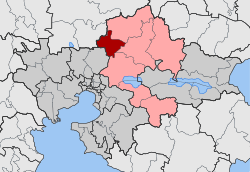Assiros
Assiros (Greek: Άσσηρος, before 1926: Γιουβέσνα - Giouvesna,[2] Bulgarian: Гвоздово, romanized: Gvozdovo) is a village and a former municipality in the Thessaloniki regional unit, Greece. Since the 2011 local government reform it is part of the municipality Lagkadas, of which it is a municipal unit.[3] The 2011 census recorded 1,975 inhabitants in the village of Assiros, 2,216 inhabitants in the community and 3,861 inhabitants in the municipal unit.[1] The community of Assiros covers an area of 55.369 km2, while the respective municipal unit covers an area of 76.657 km2.[4]
Assiros Άσσηρος | |
|---|---|
 Assiros Location within the regional unit  | |
| Coordinates: 40°49.25′N 23°1.85′E | |
| Country | Greece |
| Administrative region | Central Macedonia |
| Regional unit | Thessaloniki |
| Municipality | Lagkadas |
| • Municipal unit | 76.657 km2 (29.597 sq mi) |
| Elevation | 186 m (610 ft) |
| Population (2011)[1] | |
| • Rural | 1,975 |
| • Municipal unit | 3,861 |
| • Municipal unit density | 50/km2 (130/sq mi) |
| Community | |
| • Population | 2,216 (2011) |
| • Area (km2) | 55.369 |
| Time zone | UTC+2 (EET) |
| • Summer (DST) | UTC+3 (EEST) |
| Postal code | 57200 |
| Area code(s) | +30-2394-xxx-xxx |
| Vehicle registration | NAx-xxxx to NXx-xxxx |
Administrative division
The community of Assiros consists of two separate settlements:[1]
- Assiros (population 1,975)
- Examili (population 241)
The aforementioned populations are as of 2011.[1]
History
The archaeological site of Assiros Toumba, a 4000 year old settlement mound, is located within the territory of modern Assiros. Excavation between 1975 and 1989 at this site has made a major contribution to understanding the nature of settlement, society, economy and material culture in prehistoric Macedonia. In addition a combination of radiocarbon and dendrochronological research on building timbers and radiocarbon dates for animal bones recovered from the site has provided one of the few accurate dates for the transition from Bronze to Iron Age in the Aegean area c.1070 BC, see Dating the End of the Greek Bronze Age: A Robust Radiocarbon-Based Chronology from Assiros Toumba [5]
According to the statistics of Vasil Kanchov ("Macedonia, Ethnography and Statistics"), 500 Greek Christians and 360 Turks lived in the village in 1900.[6]
References
- "Απογραφή Πληθυσμού - Κατοικιών 2011. ΜΟΝΙΜΟΣ Πληθυσμός" (in Greek). Hellenic Statistical Authority.
- Name changes of settlements in Greece
- Kallikratis law Greece Ministry of Interior (in Greek)
- "Population & housing census 2001 (incl. area and average elevation)" (PDF) (in Greek). National Statistical Service of Greece. Archived from the original (PDF) on 2015-09-21.
- http://www.plosone.org/article/info%3Adoi%2F10.1371%2Fjournal.pone.0106672
- Kanchov, Vasil, Macedonia, Ethnography and Statistics, Sofia, 1900, book 2, p. 11. Written as "Гювезна (Гвоздово)". (in Bulgarian)
- Assiros Project web pages
- Thracians and Mycenaeans: Proceedings of the Fourth International Congress
- The Oxford Illustrated History of Prehistoric Europe by Barry W. Cunliffe
- Urbanism in the Aegean Bronze Age by Keith Branigan
- Official site of the Demos (Municipality) of Assiros
- Catalogue of archaeological sites in the Demos of Assiros